|
|
Welcome to my travel log! You will find here a lot more than in the travel reports, stripped from political correctness. Enjoy! 
Jan 01, 2002 07:00 PM Guatemala - Rio Dulce, Livingston, El Castillo de San Felipe
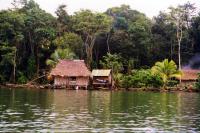 Rio Dulce was the next stop, on the way to El Petén in the northern part of the country. Río Dulce means ‘sweet river’ and is also the name of a town at the gate of the Lago Izabal. The town itself is just few uninteresting huts along the main road, but the main attraction of the place is its vicinity to the lake, the river and the Atlantic Ocean to the east.
Rio Dulce was the next stop, on the way to El Petén in the northern part of the country. Río Dulce means ‘sweet river’ and is also the name of a town at the gate of the Lago Izabal. The town itself is just few uninteresting huts along the main road, but the main attraction of the place is its vicinity to the lake, the river and the Atlantic Ocean to the east.
It is the Guatemala’s main hangout of sailors and yachters. On the river, there many small villages built literally on the water. All the buildings, including churches, are erected on stilts and the main ‘road’ is always the river. No cars, just boats, canoes. While passing by those villages, or passing in narrow canyons with the hired speed boat I thought that I finally got to see the real Guatemala, where Maya Indians live so organically. I saw entire villages fishing on the river using their narrow canoes, floating amongst pelicans, herons, cormorants…
The boat trip was one the most thrilling experiences of Guatemala. It took three hours and the time just flew. The scenery was mindboggling – river in the jungle, whose width varied from vastly wide to one-boat narrow. High cliff shores covered with dense rain forest and palm trees, or flat shores occupied by lovely villages or bird enclaves.
The number of birds was contributing to the entire encounter with the nature. Plenty of handsome herons sitting on the trees or standing on the shore in the long grass, pelicans flying around, fishing and relaxing on the surface, and I don’t even know the Polish names of the species of other birds, nevermind the English names!
Lívingston
The only practical way to get to Lívingston is by boat or ferry on the river or the Caribbean Sea. Once, it belonged to the British Empire, hence its name. It lies at the mouth of the ‘Sweet River’ right on the Caribbean coast. It is a small town without special character, well maybe the only character of this place is that the streets were not given names or numbers, at all. Everything, bars, restaurants, few hotels, houses, garages, warehouses have one common address: Lívingston, Guatemala.
Historically, however it must have been a key town. This is exactly where the Garífuna people (Black Carib, Garinagu) landed after their slave revolt on the Caribbean island of St Vincent in 1795.
It is still now also an important spot in the country as an international ferry terminal has been built here to service regular ferry/ boat connection with adjacent Belize. Travellers who come from Belize and enter Guatemala in Lívingston should be very happy to experience this pleasant shock, if they yet have not got one in Belize.
The area is extremely photogenic and the symbiosis between the people and the nature is thrilling. The uncountable pelicans sitting on the piers, and all those other species whose names I do not know, make a fantastic sustenance to your eyes.

Then travellers would have to step on another boat to get to the ‘main land’ Guatemala, i.e. to get to Río Dulce. The boat would need to take them through the river canyons, bird enclaves, on-water-villages and would most probably pass by villagers fishing from their canoes. It is a scene like from the National Geographic Channel.
This is not a short journey, the distance is approximately 35 kilometres (21.7 miles) so only a speed boat can make it within a time shorter than an hour. That is not easy because the first (geographically the last!) 10 – 15 kilometres (6.2 – 9.3 miles) of the river are narrow and the speed cannot be too high, plus all those villagers fishing on the river – you have to be careful not to knock them out or disturb the fish.
El Castillo de San Felipe
In the times of Conquistadors, the entry to Guatemala from the Caribbean Sea was already considered as very important and therefore the Spaniards decided to build a small tower to control the access. Then the tower was extended and a small castle grew around it.
It was built in 1652 in the narrowest part of the river to protect the villages from pirates who actually captured the castle and burnt it in 1686. Then, partially rebuilt, it was used as a prison. In 1956, the government decided to reconstruct the fort and create a principle tourist attraction of the Lago de Izabal. It was devastated by the locals since then and was only just reopened around Christmas time in late 2001.
The utterly hilarious thing about this castillo is that it was not reconstructed faithfully. The architect in charge added entire section to the remains of the structure – a dining area for the officers. He claimed that because similar castles in the area have such a room above the main gate, this one must have had one too. That is it – the history was changed!
Now, the official guides make up stories about the officers tired with the humid and hot climate who enjoyed themselves in this room, eating and drinking, having beautiful view to (the currently existing!) park and benefited from the little draft that came into this elevated room to cool them down. Fascinating, is it not? I actually think they believe in that.
|
Dec 31, 2001 07:00 PM Guatemala - Antigua Guatemala New Year's Party
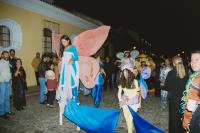 It is situated at the feet of an active Volcán Fuego (Fire Volcano) seen from every point of the town, dominating everything! Small, adorable town packed with red roofed multi-coloured one storey houses, all in fantastic condition lined up along the narrow stony streets.
It is situated at the feet of an active Volcán Fuego (Fire Volcano) seen from every point of the town, dominating everything! Small, adorable town packed with red roofed multi-coloured one storey houses, all in fantastic condition lined up along the narrow stony streets.
So narrow that it was hardly possible to fit the Chevrolet S-10 Pickup between all other vehicles cruising around. It is a really good car, when a Serb bumped into the side of the Chevy, he lost his light and had a bad scratch and the Chevy had hardly any marks at all! Bloody well right, otherwise Budget rent a car could have been really pissed off and the rental could have become too expensive.
Naturally, we had an argument whose fault it was although it was plain to see that if I called the police they would have quickly seen that the Serb was responsible. He was reversing to re-enter one of the gates, and lost control over his handbrake, so clearly there was nothing to discuss! There was some argument whether he was indicating that he was having difficulty or not.
Fortunately, we did not have to call the police because I must have been very convincing when explaining that he should have been more careful when reversing from a drive way of a building. Calling the police on the New Year’s Eve was not the most thrilling perspective, not mine or his, as the entire argument could have lasted half a day at the police station. We just wanted to get ready for the party. Peace!
Without any special observation skills, it was easy to realise that hordes of people flocked to Antigua for the last day of the year extravaganza. They represented many different nationalities from around the planet, but also many Guatemalans, mostly from Ciudad Guatemala.
The main party was organised by the mayor of the town with the contribution of all establishments located at the Calle 5a.
The party was well thought over, with many mini concerts, role plays, parades, fireworks shows, and people on stilts.
Champagne was quite expensive, but it is naturally a must for the New Year’s party, so it was imperative that one bottle, at least, had to be bought. One was enough, though. Before midnight, however, few beers found their way into my throat as well. Well done!
Just after midnight and the fireworks show, the mayor invited representatives of all the present nationalities to shout wishes in their own language into the public microphone. Many people then jumped on the stage and surrounded the mayor, who cunningly escaped the crowd and found me standing with the half full bottle of French champagne. He politely asked whether he could have a sip from my bottle. That was an interesting New Year experience – drinking champagne with the mayor of the town, straight from the bottle and the bottle was mine!
Sadly, the party did not last until the wee hours of the morning and some of the bars closed around 2am. Most of bars were run by quite young people, who also wanted to go out and party. Few clubs, with an international music were still open and busy with all the human remains from the main event. La Kasbah club comes recommended, and I can confirm that. It is a normal disco club serving all kinds drinks and playing all types of disco music. It is fantastically located in a colonial building with patio, of course.
Antigua is full of young people, who come to Guatemala to learn Spanish and stay for many weeks. It is an excellent place to party, dance, drink and eat. Some of the restaurants, even those classified as ‘budget’ look very exclusive and serve superb food like the La Fonda de la Calle Real.
The secret however is the chocolate, hot chocolate served by La Cenicienda Pasteles on the 5a Avenida Norte is a bliss. Maya invented chocolate, so no wonder it is so good in Guatemala.
Architecture of Antigua brings people to their knees. The richness of the decorations on the churches’ façades is overwhelming. The size of the main cathedral, right on the Plaza Mayor is unbelievable (picture below).
The building is as large as St. Paul’s Cathedral in London, maybe even larger. It was founded in 1542 and was built in the baroque style but ruined by many earthquakes and is only now partially rebuilt. With every renovation, the church lost most of its richness. Today, only part of the building is used. The ruined part can be visited and if I had not gone inside, I would have never realised how massive it was.
The best way to admire the town’s architecture is by visiting numerous hotels and restaurants, because this is how you get to walk inside and see how the building was constructed and how those cosy patios were fitted in the idea of the entire complex. Most of buildings come actually from the 16th century and the only modern constructions are the petrol stations. Marvellous place!!
|
Dec 30, 2001 07:00 PM Central America - San Salvador (SV) - Antigua (GT)
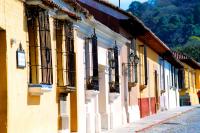 On the road this time. There is a frequent bus service from San Salvador to Ciudad Guatemala (Guatemala City). A corporation of several bus companies serves this route and buses depart every hour. The trip takes approximately three to four hours although the distance would suggest a lot less time. The distance may not be great but great are the mountains that must be climbed.
On the road this time. There is a frequent bus service from San Salvador to Ciudad Guatemala (Guatemala City). A corporation of several bus companies serves this route and buses depart every hour. The trip takes approximately three to four hours although the distance would suggest a lot less time. The distance may not be great but great are the mountains that must be climbed.
The border service at Las Chinamas is efficient and very fast. The procedure takes only two minutes. The officials may attempt to earn some extra change by asking an entry fee even if the visa is already stamped in your passport. I said that I was not going to pay any more than I have already done in London and the guy deeply apologised. There may be a queue before the desk but the bus waits for everyone.
The key destination of this holiday was Antigua Guatemala. I chose it to be the very spot for the New Year’s Eve party. I thought Ciudad Guatemala should be the one, but based on an advice of a friend, I changed it.
On the 31 December, we had beautiful weather, about 36˚C (96.8 ˚F), and cloudless skies. Antigua (as it is called in Guatemala) is the most charming place in the Central America.
|
Dec 29, 2001 07:00 PM El Salvador - Santa Ana, Volcan Izalco, Cerro Verde
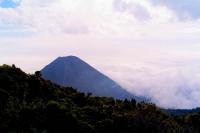 Santa Ana
Santa Ana
We stopped there only for a short while, for a cup of coffee, really. It is said to be a good party place with many different establishments to visit. The coffee place was really cosy, just across from the outstanding cathedral. It looked like a garden. There were trees inside!
The cathedral is pretty and quite big. The town itself is nice but there is nothing particularly amazing about it. Maybe I would change my mind had I stayed there a bit longer.
Volcán Izalco
This is an absolute must for any visitor to El Salvador. This magnificent volcano (pictured above on the previous page), one of the youngest in the world, had been throwing lava continually for over 180 years until 1950s and therefore became known as the Lighthouse of the Pacific. It has not spoken since 1966, but is still considered active. Smoke continues to come out of small vents in the cone.
Almost entire mountain is made of ash which contrasts nicely with the green surroundings, and other volcanoes in the area.
There is a trail up to the crater that takes about 2.5 – 3 hours round trip from the park’s entrance but can really be compared to the Sisyphean task. With every step up, you slide down two steps on the loose ash.
Well, the park was closed until further notice anyway due to security reasons. In recent months, the number of bandit groups operating in the area increased so much that the government no longer could provide enough security forces to ensure safety of the visitors and the park was closed.
Naturally, everyone is free to wander about and climb all three volcanoes on their own if one pleases but the security forces warn that people should not take anything with them. This includes any type of currency, credit cards, documents, watches, cameras, cam recorders, bags and expensive clothing or footwear. I guess it is best to climb naked…
Cerro Verde
This is the name of the national park where the three volcanoes are: Cerro Verde, Santa Ana and Izalco. It is a green area and since trees prevent spectacular views, any gap in the forest providing a glance on the area, makes it spectacular. Like the one of a crater lake of Cerro Verde.
|
Dec 28, 2001 07:00 PM El Salvador - San Salvador, La Libertad, Sonsonate
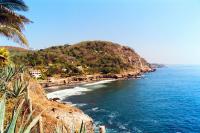 San Salvador
San Salvador
This airport, at the other hand, was a surprise! Super modern, some of the European capitals’ airports are a lot less impressive. Finally, there was a civilisation.
The entire city of San Salvador is very modern, too. Luxurious hotels and glass and steel building are not rare at all. It was a surprise also because this country is known to have been experiencing frequent earthquakes. Some of them very strong and devastating like those two in 2001, in January and February.
Still, the country is spending money on profligate buildings. Is this so different, however? Both San Francisco and Los Angeles, in California, US are prone to earthquakes, too and it does not stop people putting money in the extravagant architecture.
There are few colonial buildings and old churches in the town as well, but El Salvador should rather be admired for its landscape and nature, but not necessarily only for the best and longest point break waves on the entire planet of ours.
La Libertad
This beach is very well known to the surfers from all over the world for its longest point break.
La Libertad is not a nice place and the beach is even uglier. Surfing is the only thing that keeps this place alive, but beginners should avoid taking lessons here, because the waves may reach even 2 meters (6.6 ft) high!
The high point about La Libertad is also the bunch of superb seafront restaurants serving incredible seafood with magnificent ocean view. The lobster is affordable (USD 10 – 15, and USD is the country’s currency) and I highly recommend it. I always recommend lobsters, by the way. I had one specially made. It was grilled open with vegetables with a lot of garlic!
The plan was to stay there for couple of days on the beach and improve the skin colour, but it had to be changed because the accommodation offering in this little village was, for the lack of a better word, unsatisfactory. The shabbiness of the hotels was unbelievable! The quality of the beach was appalling, too. It was dirty and stony. So, the only choice was to look for a better spot. That was not easy.
Sunzal Atami Beach
Well, I was not quite prepared to drive half the country to find a better spot and this was exactly like it. Hours of driving around and looking where to stay. Not an easy task, as there are not many public beaches in El Salvador and there are few hotels.
Luckily, there was this Atami Beach Club, a private property comprising of several ranchos and two private beaches. The Club itself is a separate establishment and has two bars, restaurant, swimming pools and plenty of hammocks around many shaded picnic areas.
Access to this property is restricted only to foreigners and the club members who must hold an American passport but be of the Salvadoran origin. At the gate, right on the main road, there is a guard who looks very fit and extremely serious. Like he has no sense of humour whatsoever! He is there all the time and I strongly believe that he actually lives in the guard shack. He is there at night, early in the morning, in the afternoon. He takes the plate numbers of the cars and writes the details of passports or driving licences.
Just before sunset, the security at the club was making themselves more visible. Guys of a considerable size carrying massive automatic guns make an extraordinary sight. The problem is that their presence does not make you feel safer at all, because it rather makes you think what possibly could be the reason of their presence. They are clearly there for a reason, what is the reason?
Sonsonate
Insignificant and dirty town of Sonsonate has a remarkable shopping centre. I have not seen a lot nicer shopping centres in London! The connotation of the place is the contrast it makes with the rest of the town, which is very poor.
In the shopping centre, you can buy anything and everything, and go to the cinema if you like. The air conditioning works perfectly and shop assistants are very polite. There are fancy places to eat and there are fountains and benches for people to sit down and relax.
In the town itself, the streets are dirty and the buildings look like they were made of whatever could be found in the garbage pile and they do look like they are about to collapse. Quite a picture!! There are also several street markets, which contrast with the shopping mall nicely.
|
Dec 27, 2001 07:00 PM Honduras - Copan & San Pedro Sula
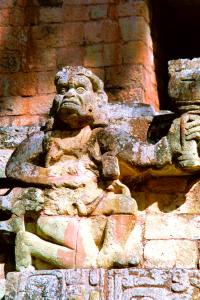 From Comayagua there are two ways up to the Mayan ruins in Copán. One goes right to the city of San Pedro Sula, which is the main road, the other goes via Santa Bárbara which is not the main road but it is a lot better. It is shorter (about 30kms or 18.6 miles), less used and in perfect condition. It is also in the mountains so the views are great. Then the road goes in the valley of the river Río Grande de Otoro, right after Santa Bárbara so it makes this route even more attractive.
From Comayagua there are two ways up to the Mayan ruins in Copán. One goes right to the city of San Pedro Sula, which is the main road, the other goes via Santa Bárbara which is not the main road but it is a lot better. It is shorter (about 30kms or 18.6 miles), less used and in perfect condition. It is also in the mountains so the views are great. Then the road goes in the valley of the river Río Grande de Otoro, right after Santa Bárbara so it makes this route even more attractive.
Everything in Copán Ruinas, the quaint town, closest to the Mayan ruins, closes down around 10pm. Everything. Hotels, restaurants, bars, tourist offices. Hotels, yes, them too. So arrival at 11pm does not help.
There was however, an Indian boy wandering about the town, maybe even the Maya, totally inebriated, no – absolutely incommunicado, who helped. He was waving his hands in so many different directions that I did not realise a human being was actually able to do that! He was also completely stoned, bloody good job he spoke some English because I am not sure if I would be able to understand any of the dialectic Spanish.
It was again an interesting situation. Square of a small, town with narrow cobble stoned streets, tidy, spotless, quiet, in the middle of the night – almost midnight. No-one in the streets, not even a smallest noise from anywhere. Street lanterns adding ambience to the tranquillity. It was kind of cool, in the jungle, close to the Mayan temples, but
surprisingly civilised, and the perspective of spending the night in the poor Mitsubishi did not actually bother me at all.
Nevertheless, the assistance from the boy came in handy. For about a half an hour, he had been repeatedly stating that the Hotellito Turista was still opened and that they had rooms available. Well, it was not opened, but we woke up the owners. The place was actually quite nice; TV set, hot water (at least until 8am there was some water), hammocks in a small patio in the middle of the hotel. Secure parking inside. Wicked!
The ruins of Copán are being described as the Mayan Paris. Situated in a deep valley, hidden by mountains, close to the Guatemalan border, they are an extraordinary link in the chain of ancient Maya centres that sweeps south from the Yucatan peninsula. While some other Mayan ruins are larger like those in Guatemalan Tikal or Mexican Chichén Itzá, no site can match the Copán’s magnificent carvings and decorations left by the rulers.
The area is still astoundingly large. There is temple after temple, and when you think this is the end of the ancient town, there still more behind this small hill, that bunch of bushes.
Copán makes a great impression. The main path from the entrance leads directly to the Main Square (Plaza Mayor) in the middle of which there is a small pyramid surrounded by stelae – Mayan sculptures, carved from all sides. They represent Mayan kings and gods.
It is awesome that it’s still possible to climb the temples, pyramids and tombs. Some people even bring their own picnic, climb on top of a temple or pyramid and contemplate the view, soaking in the secrecy of the place.
There I found that Maya were very special about their temples. Every new king or ruler would completely destroy all the temples and build new ones in their place.
The life expectancy then was around 30-40 years, but few kings are known to had lived longer than 60 years, so the temples were never getting old. The style however was changing throughout the centuries. Now, it is quite difficult to see that because the constructions that stand today were all built around the same time and date from
AD 600 – AD 900.
Under the Pyramid 16 (picture on the right), however, the archaeologists found another temple that must have been so important and universal to the Maya that they spared it. They named it Rosalila and it is a wonderful monument (picture on the previous page), very colourful, but the most astonishing fact is that it is different than all the other monuments. A humongous contrast! Well, there it is. Two pictures, one on this page and the other on the previous page – two different temples of the same culture, the colourful is the Rosalila, or rather a replica of it that now stands in the museum. The other is rather barren stone pyramid.
Sure, it should not be this strange at all that they are so different. In Europe, there are great examples of differences in the architecture. We are talking about three thousand years of time span. It is quite enough to develop different styles, have many different ideas, etc. Right? So, perhaps we should not get too excited about the different styles that the Maya had.
On the picture below, there is a photograph of a clay model of Copán. One can see that it was a harmonious city with beautiful monuments, stadium and large public areas.
Aguas Calientes, closer to the Guatemalan border, is a popular spot with hot springs, hence the name. It is attractive, I’ve heard but extremely dangerous. There are several horror stories in a few languages hung on the wall in the post office in Copán Ruinas telling how tourists were attacked by bandits in the jungle, how people’s hands were cut off with a machete. Spooky but apparently true. Keep off or organise a strong squad, that is the suggestion. I would comply.
San Pedro Sula
This town is quite unattractive, large, semi-modern buildings, like in Athens or San José. San Pedro Sula was not on the list of places to be visited. However, as we were changing the itinerary as were going along, and getting late, the flexed plan stated to drop the car, spend one night over there and catch a bus to the Salvadoran border.
As one of the Budget’s offices was on the airport, so it happened that instead of tickets for a bus, I bought tickets for a plane to San Salvador. Unfortunately, not for the same night, but for the next (early!) morning.
The airport was quite messy. It is an international airport but procedures are so strange. Free coffee makes it up, though.
|
Dec 26, 2001 07:00 PM Honduras - Tegucigalpa to Copan
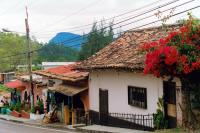 Tegucigalpa is a horrible place. I have seen seriously ugly cities in my life, but this one was definitely the ugliest! We quickly took a car and got out of there!
Tegucigalpa is a horrible place. I have seen seriously ugly cities in my life, but this one was definitely the ugliest! We quickly took a car and got out of there!
Santa Lucía
A bit higher in the mountains there is this small, nice village with cobble stoned street and tailed roofs. It is overstated in the guidebooks that it is a picturesque place, absolutely beautiful, etc. Easy, easy, it is not that gorgeous – it is just a lot nicer than Tegucigalpa and because it is in such close vicinity, it contrasts with the capital enormously.
Surely, it is all worth the trip because it’s different and the winding way up to the Valle de Angeles offers unforgettable views to the mountains, where the clouds hang low, touching the top of the rain forest, then higher - the pine forest. The road is in an excellent condition, like most of the roads in Honduras so I should recommend this escapade.
Valle de Angeles
There are two things about the Valle de Angeles: one is the incredible valley, the other is the pretty little town of the same name.
In the valley, between the Santa Lucía and Valle de Angeles, is a popular (as claimed by the Lonely Planet) park and picnic area used by locals. Well, I have not seen anyone over there apart from two members of staff.
First, was the man who came up with his gun and demanded an entry fee. At the beginning, I thought it was funny to see someone approaching you with a real, quite large gun, but my thought did not last long. His face was deadly serious proving only that ‘hey, you – pay promptly as I will not have second thoughts about using my gun’.
There was absolutely nothing to do there. The second person was a woman at a small refreshments area, which did not have many refreshments at all. This place looked abandoned. Still, the entry fee was in force, enforced, forced… what’s the word?!
The town Valle de Angeles was in contrast very welcoming. Interesting architecture, plenty of art craft and tranquillity. I should imagine that this would be a great place for lunch or dinner. I’m sure that all the tourists who are trapped in Tegucigalpa, even if for just a little while, come up here to chill out and inhale one of the different flavours of Honduras. There is a small square in the heart of the town and there is a great chance to see the scarlet macaws flying low over the roofs and sitting on the square’s trees.
Weather was of exactly the tropical forest kind on that day. Raining. The 1980’s looking but three-year-old 4WD Mitsubishi could not cope with the slippery, muddy, very narrow road up to the national park of La Tigra. At one point, it became just too dangerous and too late to continue. The plan was to reach Copán still 300 kilometres away that day having still visited Comayagua and the watch was already showing 3 o’clock in the afternoon.
Comayagua
The former capital of Honduras is a typical colonial town, no surprise here then. It is small and very Central American, even some of the cities in Cuba look similar, from the urbanistic point of view at least. One storey, small houses, painted in vivid colours. The square in the centre. The old striking cathedral with signs of times that make it ever more attractive.
Well, this one was being renovated, and the restored parts of the façade were stunning, very richly decorated.
It was already well after sunset so the stroll around the town had to be limited. The stop-over was actually made here for dinner, because during the hours of darkness, visiting any place in Central America is neither safe nor comfortable.
Dinner was absolutely fantastic. The best restaurant in town, magnificently located and decorated. The atmosphere of the place is like taken directly from the Zorro films. The tables are situated around the central patio under the circular archway. A small fountain in the centre of the patio, amongst young palm trees. Tastefully lit. Definitely the highlight of the day. It is a pity that I do not remember the name of this restaurant.
|
Dec 25, 2001 07:00 PM Nicaragua - Leon & Leon Viejo (UNESCO)
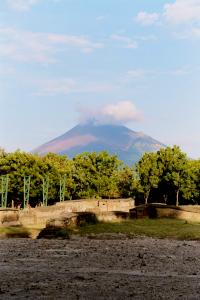 León Viejo
León Viejo
This is one of the world’s examples of the volcano’s destructive power. León Viejo is a town (or rather remains of it) at the shore of Lago Xolotlán (or Lago de Managua). It was founded by the Spanish general Francisco Hernandéz de Córdoba in 1524 and quickly became a remarkably wealthy city of Nicaragua. The prosperity lasted only 86 years as the magnificent Volcán Momotombo, the Nicaragua’s national symbol, a perfect cone, created an earthquake in 1610, which completely destroyed the city with its brand new cathedrals, palaces, markets…
Before it happened though, the founder of the city, based on the decision of the king of Spain, was beheaded in the main market square and whose remains were excavated from the ruins in May 2000 and entombed across from the ruins of the Cathedral Iglesia de la Merced.
This site is considered as one the most important monuments of the human heritage and is now protected by the UNESCO, like The Great Pyramid in Giza (Egypt), the Salt Mines in Wieliczka (Poland), the Old Town of Cracow (Poland), La Habana (Cuba), Fés (Morocco), Athens’ Acropolis (Greece), and many more around the world.
This one however, is not as spectacular and if the view over the Momotombo were not incredible, the León Viejo would not be worth the trip. The ruins protected by the UNESCO do not impress at all. There are only few bricks sticking hardly out of the grass and that is it. It requires quite a bit of imagination to visualise what the town might have looked like some half a millennium ago. Luckily, León Viejo is just about 30kms (18.6 miles) from León, the former capital of Nicaragua, which is in better shape.
León
Moved from León Viejo right after the earthquake, and at the very beginning poor, León soon became a cultural and intellectual stronghold of Nicaragua and continued to be its the capital for more than 300 years.
It is truly an attractive town. Most of the buildings are original and despite the fact that they must have never been redecorated since they were erected, makes the place even nicer and more mystical. The humongous cathedral in the heart of the city makes a very good brunch view from one of the square’s cafés (picture below).
Albeit León is no different to other colonial Nicaraguan towns. Pretty inside, in the centre, full of vivid colours, maybe a bit faded through all the years but outskirts are run down, simple, poor like the entire country. The farther you go however, the more friendly faces you find.
It is a fantastic spot to party, too. So I heard. So I did, in fact. Maybe to a bit too large amount as well, I suppose. It was great though and people were … patient, very patient! I also need to confess that due to a busy night, I cannot say too much about the town. So, let’s move to another place, shall we?
|
Dec 25, 2001 07:00 PM Central America - Leon (NI) to Tegucigalpa (HN)
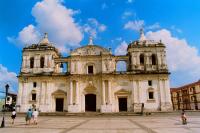 Chenandega is a larger town closer to the Honduran border where streets have no names and almost all of them are ‘one way’. The problem is that there is no way of guessing which way. No signs, no clues, no idea. Driving is therefore hell, no kidding. The locals must have a great fun watching poor tourist driving illegally the wrong way up. It happens even so frequently that they just wave greening enormously desperately making all efforts to explain which way is the correct, legal way.
Chenandega is a larger town closer to the Honduran border where streets have no names and almost all of them are ‘one way’. The problem is that there is no way of guessing which way. No signs, no clues, no idea. Driving is therefore hell, no kidding. The locals must have a great fun watching poor tourist driving illegally the wrong way up. It happens even so frequently that they just wave greening enormously desperately making all efforts to explain which way is the correct, legal way.
The police must have stopped getting upset about this long time ago and the government must have binned the idea of signposting the towns soon after.
The town was never in the plan to visit at all. So, as it happens, that the plan was changed slightly. It was only because there was a Budget office over there and due to the unplanned partying in León there was no time to lose – three countries were still waiting to be visited and they definitely were remaining in the plan.
It was a tight plan according to which the New Year’s Eve should be spent in Guatemala already, which was three countries away.
So, I cannot say Chenandega was actually visited. Only driven through and in all the wrong directions. It was an easy place to cross the border in an independent manner – a taxi, because it was just an hour and a half away.
The procedure on the border was not a surprise this time round, but it was a lot less pleasant and not just because it was during the hours of darkness. The procedure was the same but it just took forever. It resembled the old times of the communistic red tape that was so popular in Poland between 1946 and 1989.
One thing, at the other hand, was remarkable about this place – a beautiful girl, smiling a lot, looking at me – an exotic individual standing impatiently at the immigration desk trying to pay her USD4 entry fee. Impatiently, because the night had already fallen all the way until then, and being stranded at the Honduran-Nicaraguan border (in other words – in the middle of nowhere) was not the best perspective. I even did not actually know where I was – forgot to look at the map.
Well, the pretty and smiling girl did not help the procedure go faster and there, and all the public transport at the Honduran side was gone for the day. This is the time when, not so suddenly, the warning messages issued by the US and UK governments about the travel to Central America make a nasty flash-back in your head. One thing is true, though. Want to be safe and free from too high blood pressure? – Do not cross any Central American borders at night! Well, definitely not this one!
No buses, no taxis. Few booths with some unidentified junk food were closing down and therefore some people were still there, fortunately. These people were so kind to confirm that the last bus in any direction was gone more than one hour ago hence there was no more transport away from that place.
Almost panicking, almost but not quite yet. There was this one thing that was making me very happy at that moment – I spoke Spanish! Without that, I would have had a bloody good reason to panic.
Two questions thrown at a small group of people and there it was – a minibus to Choluteca, the first middle size town from the border. The fee was USD2 and all the others, many more than the manufacturer of the vehicle could ever guess, paid the same fee. Even this one who brought five gigantic containers full of fish, which were placed on top of this poor car. Ha, movement! This is what counted as at that minute.
Apparently, the driver was going to take the fish-lady to some small village and therefore the stop at Choluteca’s main bus terminal did not sound bad at all. Instead of buses, which were all gone, there were taxis. As soon as the drivers spotted the foreign make of the luggage, they thought – ‘what a catch!’ And I thought – ‘not so fast!’ I am not an easy target like that anymore.
I cannot now remember how much they wanted for the ride to Tegucigalpa, something around USD120, but one of the drivers had to agree to go for USD65, a good ride to complete this day, anyway.
All the way to the capital of Honduras was uphill. A long, tiring drive between potholes, first-gear-steepness, winding road. It was incredibly scenic, volcanoes, precipices all the way. Normally on such a dark night, I would not be able to say. Maybe on a full moon night, maybe, I do not know. This night was very dark and the only way I could figure out the scenery was because of five or six thunderstorms. The lightning was very frequent and the atmosphere was getting increasingly more thrilling and fantasy-film-like.
Suddenly, I forgot about the increased level of adrenaline that kicked in at the border. I was not quite sure whether to regret that it was so dark and most of the scenery I had to be imagining, or to be happy that it was so cool with the lightning and all.
The driver stopped several times on the way to make some shopping and to take a wiz, twice. Fine, but after two hours of slow driving in a very, very old automobile, older than myself, uncomfortable and noisy, I was getting impatient again and hungry. It was almost 9pm and the only thing I could remember of food that day was small breakfast in León.
|
Dec 24, 2001 07:00 PM Nicaragua - Granada and San Jorge (Volcan Concepcion)
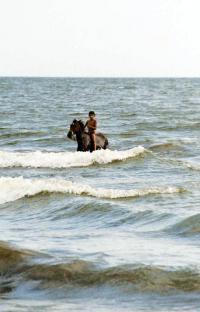 Once the richest place in the Americas, Granada, had it glorious times just after Columbus’s arrival. It is a pretty colonial town, a pearl of urbanisation with colourful houses, clean streets, and really friendly people.
Once the richest place in the Americas, Granada, had it glorious times just after Columbus’s arrival. It is a pretty colonial town, a pearl of urbanisation with colourful houses, clean streets, and really friendly people.
I was so proud of myself that it was my plan to spend Christmas Eve in Granada - a pretty and friendly place. Perfect plan.
Granada makes best first impression in the evening, exactly when I arrived. It was actually completely dark, just starfull skies and dimmed street lights, lights from the bars and restaurants, private homes.
In addition, there were petards, simple, home-made fireworks, made of newspapers, and devil knows what else. Great! It finally felt safe, maybe because there were many more tourists than on average can be seen in Central America.
It was great to sit at a table in the street, saying ‘hi’ to people passing buy, drinking local rum, best rum in Central America in fact, ‘Flor de Caña.
It was brilliant to see people in a good Christmas mood, in a country far, far away. Happy, joyful, blissful, delightful, singling, dancing, firing those noise and light makers!
In the morning, however, it did not look too bad either. All the colours of the small, colonial buildings make them very photogenic, by the way. It composes a look of it being so… liveable, like you want to stay there, forever. Even the shacks of very poor people are painted in bright, vivid colours.
This place is really worth visiting, it is worth staying a few days, I believe. It’s well organised and it is close to other interesting places, like active volcanoes, colonial places, lakes, the jungle, the beaches…
Life in Granada resembles nothing of the life in the London City. It is peaceful. People take it easy, no rush. Relax. Like this man (picture on previous page), lying at the blue door after the night of the Christmas Eve, easy, ‘it’s just ten o’clock in the morning’ mood – it’s the day off, it’s Christmas, what’s going to happen?!
Yet, one must be careful. The locals, no matter how friendly, know that most of the tourists are the ‘rich gringos’ so they have developed way to benefit from this fact.
This little, insignificant, if sweet, town at the Lago de Nicaragua is one of the best spots to view the largest island on a fresh water lake in the world – Isla de Ometepe. It has been formed as a result of the rise of two volcanoes, both of which are still considered dormant. That is the view I saw right after the crossing the Nicaraguan border. I had to come back to see it properly.

The town on the main land is proud to have two nice beaches on the lake. It is very popular as well, few buses from the country arrived packed with people eager to have a swim in their national lake.
I was so lucky to be there early in the morning on the Christmas Day when hordes of people swim in the lake, having fun. They smile and wish to be photographed. That was a massive contradiction to what I had read in the guidebooks, which said that taking pictures is not advisable because people may get upset. Apparently, few incidents took place that tourist were murdered for taking unauthorised photographs of the villagers’ children.
The island in the middle of the lake (almost in the middle) is magnificent. The perfect cone of the Volcán Concepción makes an unforgettable view. It is even hard to describe what it is like. I have never seen anything similar to that.
On the way from Costa Rica, which was early afternoon, the view was breathtaking. After having spent few days among all the volcanoes, I learnt that the best view over a volcano higher than 1,800 meters above sea level (5,900 feet) is around noon. At all other times, clouds obscure the top of the volcano and spoil the view.
I arrived to this conclusion before I went to see and take the picture of the Volcán Concepción, as the 8am – 9am did not prove to be the best timing. It made a long day, but the photographs would have been a lot better with blue sky and full view of the marvellous mountain.
At the other hand, being on the site early, means that one becomes a witness to a genuine morning life of a little Nicaraguan village.
Some people will simply relax and do nothing on the beach, some will swim in the lake fully dressed, and some will wash their horses in the lake – like this little boy did. He was riding the horse on the beach and then suddenly went into the lake (photograph below). That was incredible!
It was a picture that felt like being taken from a fairy tale, a legend or a myth. Well, it felt like that to me, because, being from Europe I have never seen naked boys riding horses in a sea or lake. The fairy tales I was told when I was a boy, were always happening in a land far, far away – almost as far as Nicaragua.
The picture of the boy riding a horse in Lago de Nicaragua is one of my favourite pictures I have taken to date.
|
Page:
 106 107 108 109 110 111 112 113 114 115 116
106 107 108 109 110 111 112 113 114 115 116

|
|
|
